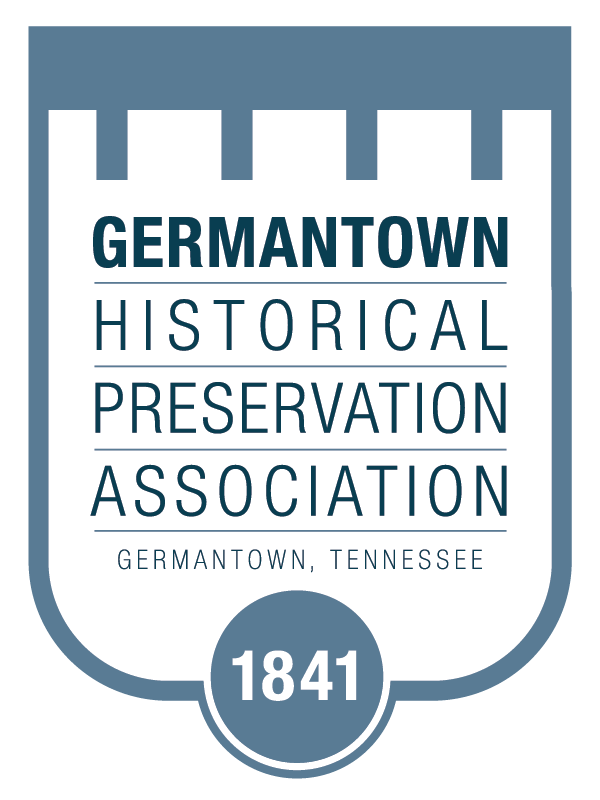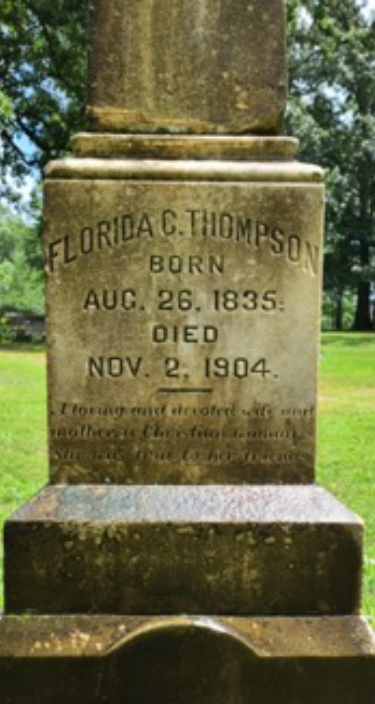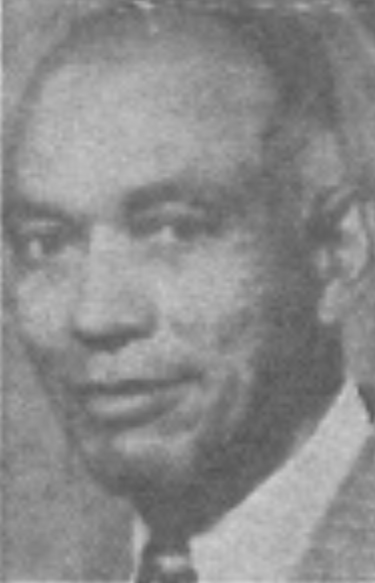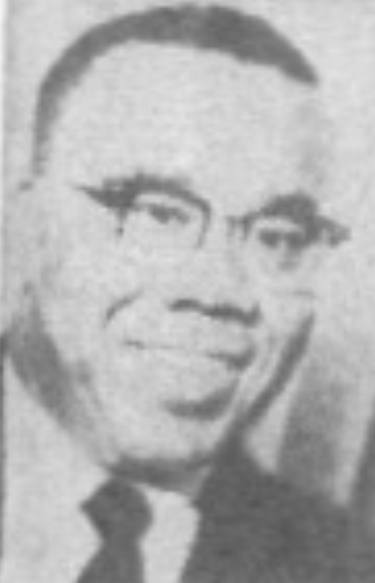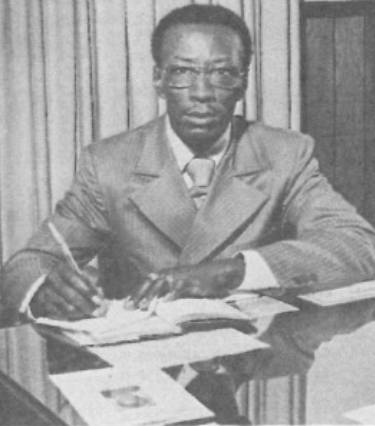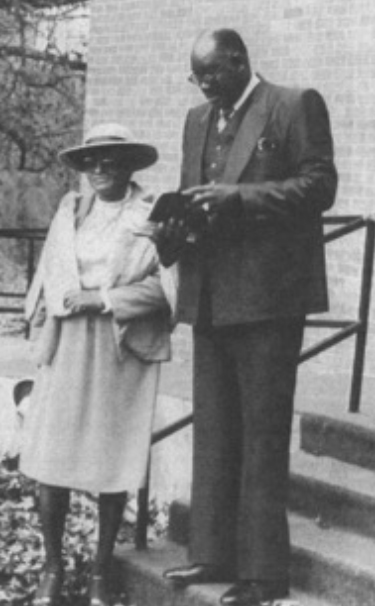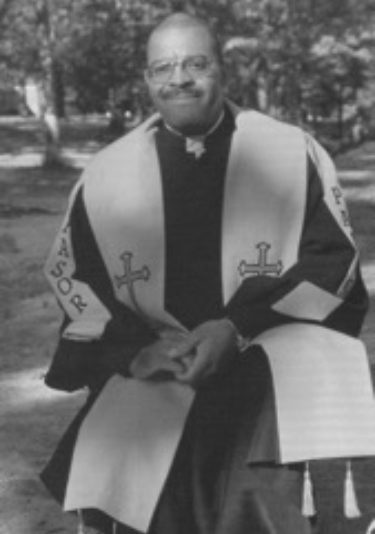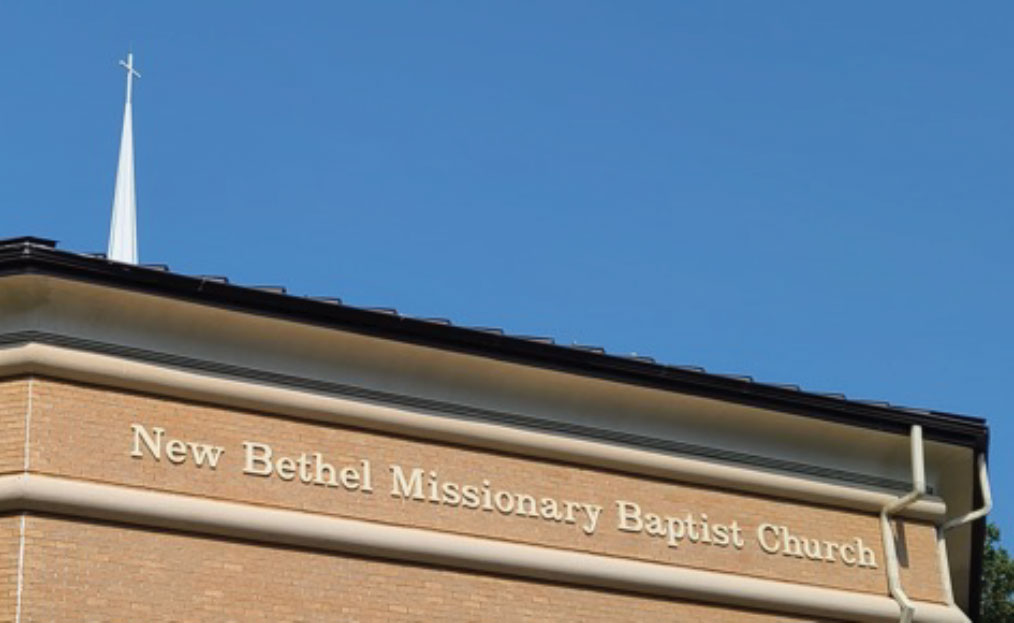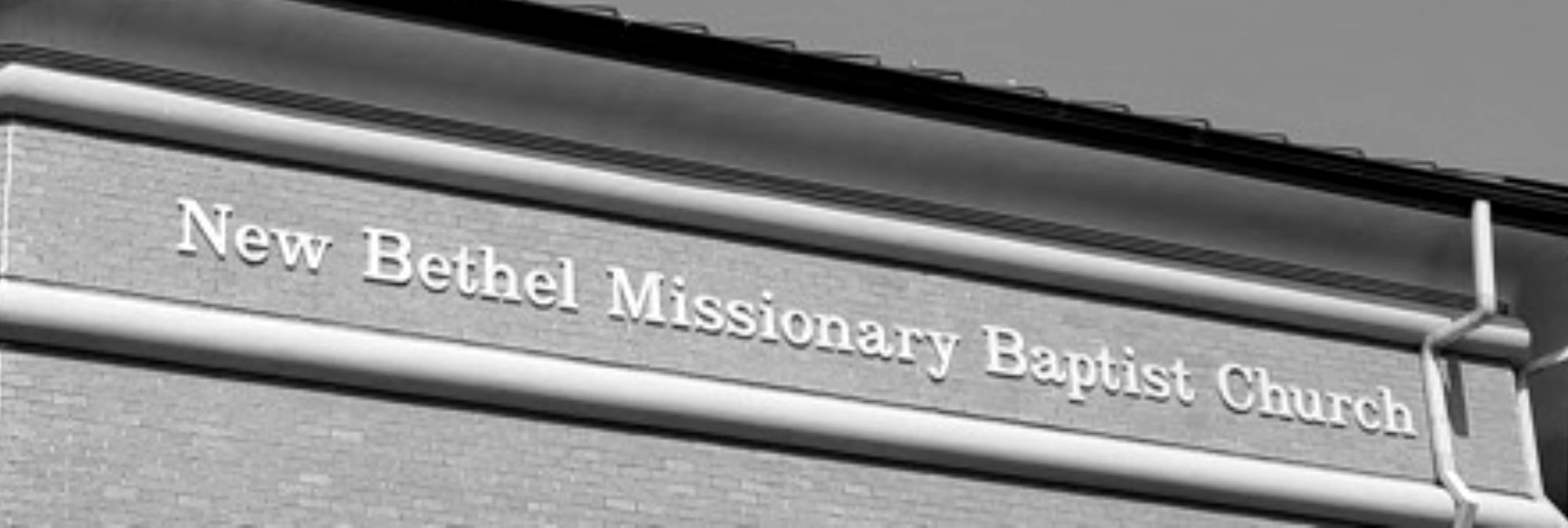
New Bethel Missionary Baptist Church
By Andrew Pouncey
Prior to the establishment of New Bethel Missionary Baptist Church, Mrs. Florida C. Thompson, a member of a prominent white family in Germantown, TN, made available a tract of land for a church so that slaves could worship and learn to read and write. This land was located on or near the present church site. Services were rendered in an old-fashioned way in a structure known as a “brush arbor.”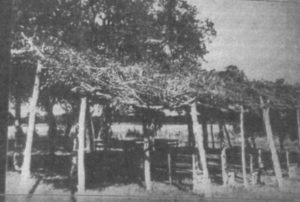
When these slaves became liberated people, they continued to worship on this site. However, it became necessary that they relocate and purchase land to build a permanent structure.
Rev. Issac Cotton
Under the God-fearing, stern leadership of Reverend Issac Cotton, along with James Scott, James Cornelius, Godfrey Goode, and others, the land was purchased from Mrs. Eliza Cornelius for the purpose of building a church and school. 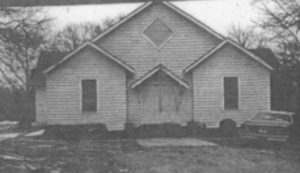 The land was purchased for the sum of two hundred dollars. This transaction was recorded in the Shelby County Register’s Office on December 15, 1869 (Book 73, Page 374). Thus is the beginning of the history of the New Bethel Missionary Baptist Church.
The land was purchased for the sum of two hundred dollars. This transaction was recorded in the Shelby County Register’s Office on December 15, 1869 (Book 73, Page 374). Thus is the beginning of the history of the New Bethel Missionary Baptist Church.
Rev. Issac Cotton served many years as the church’s first pastor. While in office he saw a need to further advance the cause of education. His ideas were presented to the church and with the direction of trustees Phillip Cornelius, Ed Finch, and Alfa Hall, were authorized to deed an acre of land to the 11 School District, Board of Directors of Shelby County for the purpose of building a school. The establishment of this school provided public education to the African American community for the first time. This transaction was recorded in the Shelby County’s Register’s Office on May 15, 1886 (Book 921, Page 77). Professor Napoleon Bradley was the first principal of the school which was named Germantown School.
Rev. Jack Bradley
Rev. Issac Cotton died while in office and was succeeded by Reverend Jack Bradley. As the church membership grew under his pastorate, additional land was purchased.
Alfa Hall and other trustees purchased 14 ¾ acres of land adjacent to the church property from Mrs. Florida C. Thompson for a sum of three hundred fifty dollars ($350.00). This transaction, recorded in the Register’s Office on May 24, 1897, is contained in Book 198, Page 228.
Another school was built on a portion of this property. Professor R.H. Nevils succeeded Professor Bradley as principal of the school. Professor Nevils taught in the Germantown School but left to teach in the Memphis City School System. The property where the old school stood reverted to the church and is now being used as the church cemetery. It was then that the record in the Shelby County Register’s Office was transferred on May 24, 1897, from Book 73 on Page 274 to Book 251, Page 624. Mrs. Gazella Watkins Brown, a member of a prominent family of Black educators, became principal and served in the Shelby County School System for more than fifty years.
Rev. Ben Nabors
Rev. Ben Nabors was elected pastor of the church succeeding Rev. Bradley who died in office. Rev. Nabors was an exemplary leader who was forthright and honest. He was well-known for his ability as a minister and often admonished Black men to stand stall, be God-fearing, and truthful.
Another member of the church, Miss Mary A. Bradford, who served as church clerk for many years succeeded Mrs. Gaxella Brown as principal of the school. She served as principal from 1911 until the end of World War 1 (1918).
It was then that the church authorized the trustees to deed the Shelby County Board of Education three acres of land to improve the educational facilities and to receive some aid from the Rosenwald Fund. This transaction was recorded on November 16, 1917, in the Register’s Office and is contained in Book 454, Page 389. It was during this period that the name of the school was changed to the Neshoba School.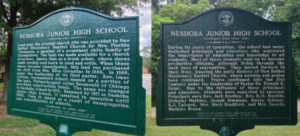 During the war, the Town of Germantown changed its name to Neshoba due to the anti-German sentiments at the time. Rev. Nabors died while in office.
During the war, the Town of Germantown changed its name to Neshoba due to the anti-German sentiments at the time. Rev. Nabors died while in office.
Rev. D.C. Patterson
Rev. D.C. Patterson succeeded Rev. Ben Nabors as pastor. Rev. Patterson was a formally educated man. He appealed to the intellect of the young and old. The school facility needed more land for necessary improvements. The church, along with the surrounding community, sponsored programs to purchase three acres of land adjacent to the church property. During the pastorate of Rev. Nabors and the administration of Miss Bradford, an American merchant and philanthropist, Julius Rosenwald, established a fund in 1916 that contributed to the building of rural Black schools. The land was purchased from Minor and Ada Callis. The transaction was recorded in the Shelby County Register’s Office on July 2, 1930, (Book 1,358, Page 62).
Prior to the pastorate of Rev. Patterson, Miss Bradford retired from the Shelby County School System and began teaching in the Memphis City School System. Her absence brought forth
Prof. Nicholas Giles Watkins, Sr., a young man who was also a member of the church and served as a deacon. He became principal of the school and continued to work closely with the church during his administration. He allowed those students who were seeking Christ to attend revival services during school hours. Professor Watkins is fondly remembered by many and known widely for his accomplishments as an educator and civic leader.
Professor Nicholas Giles Watkins, Sr.
During the ministry of Rev. Patterson, Professor N.G.Watkins, Sr. was instrumental in the promotion of the school from elementary to junior high. He was also responsible for the first school bus transportation for the children of the Neshoba School and surrounding areas. Prior to that, some students had walked as far as fifteen miles to school. Mr. Johnnie Lane was the first bus driver to serve in the Neshoba School area. Later, more buses were added. Professor Watkins also headed one of the best Black athletic programs in Shelby County.
Rev. Jackson
In 1937, the church burned, and services were held in the Neshoba School Auditorium. Rev. Patterson, a faithful shepherd, became incapacitated by illness, and the Rev. Jackson assumed the banner of leadership for New Bethel. During his pastorate, the worship service was transferred from the school to the Masonic Lodge Hall. The Masonic Lodge was owned by the church and was located near the site of the church’s original structure, on the southeast corner of the property. Rev. Jackson, who was advanced in age was wise and as prudent as his years. He retired and was succeeded by Rev. A. Edmondson.
Rev. A. Edmondson/Rev. Grafton, (1939 -1944)
Under the leadership of Rev. Edmondson, the burned church was rebuilt. The first worship service in that building was held in 1939. After a few years of service, Rev. Edmondson was not reelected and was replaced by Rev. Grafton. However, because of responsibilities and commitments elsewhere, Rev. Grafton resigned and recommended that Rev. L.J. Peppers succeed him.
Rev. L.J. Peppers, (1945-1960)
During Rev. Peppers’ ministerial association with New Bethel, great strides were made, resulting in changes in the worship service and financial procedures. The church realized a greater sense of community involvement and began to institute social service programs. Many debts owed by the church were cleared, but others were incurred as the church progressed steadily and swiftly. A cafeteria and baptistry were also built. Rev. Peppers accepted the opportunity to move to a larger congregation.

Front Row
L. to R.: Unknown, Mrs. Boyce, Unknown
Second Row
L. To R.: Deacon Alonzo Barber, Mr. Simmons – Principal of Neshoba Black School (1950-1960), Mrs. Simmons, Rev. Boyce – 9th Pastor of New Bethel (1960-1963), Mr. Higgins – Teacher at Neshoba (1950-1960)
Rev. L.T. Boyce, (1960-1963)
The Rev. L.T. Boyce, a young product of the Germantown community, came forward to take up the reins of leadership at New Bethel. He was an eloquent orator, who rendered informatively, often poetic, sermons. He was also quite charismatic. Under his pastorate, membership increased, and the church became financially stable. Rev. Boyce served as pastor for three years before leaving to assume the leadership of another church in Buffalo, New York.
Rev. S. L. Wicks, (1963-1981)
The void left by Rev. Boyce was filled by Rev. S.L. Wicks. Under his leadership, the church continued to progress. The church was extended and bricked, a modern heating and cooling system were installed, a foyer was added to provide additional restroom facilities, the parking lot was resurfaced, and the church library opened. During the remodeling stage, the church received permission from George Barnes, Superintendent of Shelby County Schools, to hold services in the Neshoba School Auditorium.
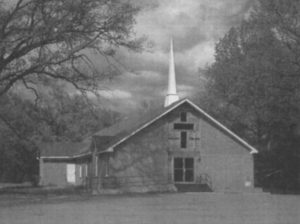
Brick Church
Professor Watkins retired as the school principal and was succeeded by Professor J. Simmons. Professor Simmons worked closely with the Parent-Teacher Association. Many members of the church held executive positions on the P.T.A. Board. Deacon Alonzo Barber was the first president of the Neshoba P.T.A. Professor Simmons was succeeded by Professor Henry Grinner. Professor Grinner was a capable administrator who felt that the students should be exposed to the arts. He served as principal during the early stages of integration. He was succeeded by Mr. B.J. Calvard, who served as principal until the closing of Neshoba School.
When it was learned that the school would close, Rev. Wicks conceived the idea of purchasing the school building and using it as a religious education building. He appointed a committee to contact the Shelby County Board of Education and put on record the church’s interest in purchasing the school building. The committee met with the superintendent of Shelby County Schools and was informed that the deed to the school property contained a no-reversion clause, and the policy of the Board was to put the property up for bid. It was at this time that the committee recommended that the church obtain legal representation. Attorney A.L Pressgrove was selected, and it was his opinion and that of the committee that the property should be returned to New Bethel Church. It was, after all, the church’s forefathers who had seen a need for public education for their people. It was through their sacrifices that land was provided for the purposed of building a school. The Board agreed to deed the property back to the trustees of the church and their successors in office. Through the efforts and sacrifices of members and friends, the church was able to purchase the school building, which was used by the community for religious and recreational activities. These transactions have been recorded in the Shelby County Register’s Office. Rev. Wicks served as pastor for eighteen years, until 1981. During his pastorate, Rev. Wicks served as first Vice-President of the Zion District Sunday School and Baptist Training Union Congress and later served as President. Rev. Wicks was asked to resign in 1981.
Rev. Frank Itson
In March of 1982, a stabilizing force came to New Bethel in the person of Rev. Frank Itson. His sermons were revealing, frank and dramatic. As evidenced by the shaking of his shoulders and legs and the tossing of his handkerchief, his presentation for the gospel was truly unique. Rev. Itson was known as the “cheerful giant” because of his friendly manner. Because of his wise and kind demeanor, many sought him for counsel. He proved to be a very capable leader, who had great aspirations for his church. Rev. Itson stated that he had asked God for three things when he came to New Bethel. – stained glass windows, a church van, and a clear mortgage. He initiated aggressive programs to accomplish his goals. Under his pastorate, a program titled Miracle Operation Complete cleared the indebtedness, stained glass windows light fixtures and ceiling fans were added, and a van was purchased to provide transportation. A central heating and cooling system were provided for the cafeteria and windows and doors were installed in Education Building A.
Rev. Itson served as Vice-Chair of the Zion District Association from 1986-1990 and was Second Vice-Moderator from 1990-1994. During the later years of his pastorate, Rev. Itson was plagued by illness but continued to preach the word. On July 3, 1994, he delivered his last sermon, and on July 6, 1994, God called His servant home.
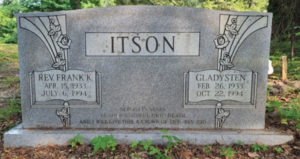
Rev. Donald R. Ester, Sr., (1995 – )
Rev. Donald R. Ester, Sr. (http://newbehel.org/pastor) succeeded Rev. Itson, becoming the twelfth pastor of the historic New Bethel Missionary Baptist Church. Rev. Ester, a native Memphian, is a graduate of Geeter High School and received a B.A. degree from the Tennessee School of Religion. Prior to coming to New Bethel, he served as associate pastor at Morning Grove. Rev. Ester was elected pastor Saturday, March 2, 1995, and preached his first sermon as pastor on Sunday, March 3, 1995.
Rev. Ester is a realistic, visionary leader with superb administrative skills, coupled with dynamic people skills. His personality and background blended with many traditions and values held by the church. One tradition was outdoor baptisms. At his urging and planning, the annual outdoors baptismal services were restored and held annually around the historic outdoor pond.
Baptism in Pond Outside Church
Under Rev. Ester’s direction, New Bethel’s leadership role in the community was restored and redefined with expanded and new ministries designed to meet the needs of the total person, the family, and the needs of the community. Added ministries include a children’s church and nursery, children’s Bible Study, a computer lab designed to train youth and audits for competitive jobs and opportunities, male and female basketball teams, and a co-ed volleyball team. The recreation grounds and athletic fields have been refurbished and host the Annual Church/Community Picnic, established by Rev. Ester.
Using proven methods established by the forefathers of school, home, and church working together, Rev. Ester organized the New Bethel Summer Camp for children ages 5-13. At the camp, children are nourished with a variety of hot meals, tutored in a number of secular subjects, and nurtured with spiritual teaching from the Bible. Another ministry established under Rev. Ester’s administration is New Bethel Pride, a Christian girls ministry for ages 13-18.
The teaching ministry, which includes a graded Sunday school, weekly Bible study, Mission Education, Nurture for Baptist churches, Boys II Men, and singles ministry, has continued with annual Leadership classes and Christian Education institutes to train leaders. The Youth Ministry uses mentoring programs, lectures, retreats, and other activities to involve the youth of all ages in Christian training and social development. Youth involvement is not restricted to the church family but extends to the community. Regularly scheduled activities are also conducted on-site. Under Rev. Ester’s spiritual guidance, the membership has increased significantly.
The Outreach Ministries include ‘Sunday School Without Walls’ and the Seniors’ Ministry. ‘Sunday School Without Walls’ meets weekly at the High Point Nursing Home to provide instructions on the previous week’s Sunday School Lesson and Communion Services. The Seniors’ Ministry, in conjunction with the Neshoba Alumni Association, erected a monument in front of the old school and presented it to the church during the 1994 Diamond Jubilee Plus 2 School Reunion. The church continues to serve the community by providing housing for a variety of activities.
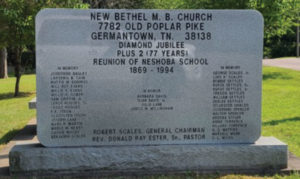
1994 Diamond Jubilee Plus 2 School Reunion Marker
New Church Building
Groundbreaking for a new church building was celebrated on October 25, 1998, on the southeast portion of the property. The church hired Bill Fuller as architect and Rose Construction as the contractor. The building was completed on August 13, 2000.
On January 1, 2001, the educational center, the old Neshoba School, burned. The school had served as an educational institution for about 75 years. The church hired Capstone Construction, Inc and Architect Ron Scobey of Professional Design Resource to rebuild the facility. Construction began December 4, 2001. The church received the keys to the building on May 15, 2002, and voted to name the new building New Bethel-Neshoba Family Life Center. The building was dedicated Sunday, August 11, 2002, with the Rev. James Smith, a former student of Neshoba as the speaker.
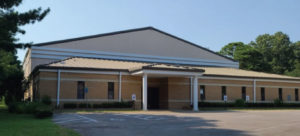
New Bethel-Neshoba Family Life Center
Source:
http://www.newbethel.org/history/
The data was researched by F. Odessa Tate, the late Mable McNary Tuggle, Charles K. Bennett, and Cheryl McNary – by Katherine Bennett 2.24.-03
